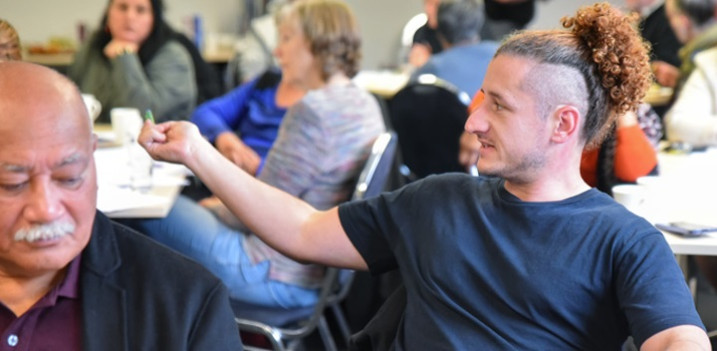Making collective decisions | Te whakatau ā-rōpū
The outcomes achieved by your transition will depend on having the authority to make decisions with impact.
On this page
You and your community may have decided upon a transition’s aims and pathways, but the decision to act will often rest with external people and institutions. A useful way to think about this is top-down and bottom-up decision-making.
Top-down decision-making involves decisions from formal positions of authority
Top-down decision-making can be very efficient, and create clear, well-organised processes with access to the resourcing needed to make things happen.
But top-down decision-making has many well-known shortcomings. It is difficult, if not impossible, for centralised decision-makers to have access to all the relevant information about a particular policy and its consequences.[1] Top-down decisions may also lack public legitimacy, because the people who are affected by these decisions did not participate in the decision-making process or agree to its outcomes.
Consent and trust should not be sacrificed for the sake of urgent or decisive action. The mantra ‘nothing about us without us’ speaks to a broad human desire to participate in decisions that affect our interests.[2]
Community-led processes involve bottom-up decision-making
With bottom-up decision-making, key decisions lie with the communities who are affected by change. Therefore, the people being affected by change can bring their insights, experience and knowledge into the decision-making process.
Community-led transitions are closely associated with the ideal of participatory democracy, where citizens are directly involved in decisions that affect their lives. Because people are involved in decision-making, or have access to opportunities for influence, there is greater consent and trust – and therefore greater legitimacy.
One model is the citizens’ assembly, which involves a random selection of citizens who are supported to engage in structured conversation about a particular topic, such as climate change or social issues, to produce recommendations about what to do. These assemblies function as a miniature public, bringing the perspectives and experiences of ordinary people into the decision-making process.
Some prominent examples in climate change and sustainability transitions at a national level are:
Irish Citizens’ Assembly(external link) — citizensassembly.ie
France’s Citizens’ Convention on Climate(external link) — conventioncitoyennepourleclimat.fr
Climate Assembly UK(external link) — climateassembly.uk
Porirua citizens’ assembly (Greater Wellington)
Porirua community leaders support talanoa* and a Te Tiriti-based wānanga forum – or citizens' assembly – led by local iwi Ngāti Toa Rangatira for the hapori community to talk about the biggest issues facing the city. The talanoa is a regular standing forum for Porirua’s community leadership to engage with each other. The Te Tiriti-based wānanga is for a representative group of the wider Porirua community to deliberate and make recommendations in ways that reflect the founding agreements in Te Tiriti o Waitangi.
I tiki mai whakawhiti te ra: A Porirua Te Tiriti based climate assembly(external link) — Inclusive Aotearoa Collective Tāhono
Ngāti Toa launches Te Tiriti-based citizens assembly to discuss Porirua issues(external link) — Stuff
* Talanoa is a Pacific Island form of deliberative dialogue.

Photo credit: Roozbeh Karimi. Courtesy of the Porirua Community Leaders’ Forum
Top-down and bottom-up options can be combined
Hybrid models can draw from the strengths offered by both top-down and bottom-up approaches. For example, bottom-up approaches that enable legitimacy, flexibility, experimentation, locally appropriate solutions and collective insight can complement top-down approaches.
In representative democracies like Aotearoa New Zealand, governments and parliaments make decisions and pass legislation using top-down processes. Yet they remain accessible to bottom-up influence through electoral offices, public consultation, submission processes, lobbying and political party membership. Input may also be sought from expert, sectoral or local advisory groups.
Examples of hybrid approaches include:
Land and Water Forum(external link) — landandwater.org.nz
Tax Working Group(external link) — taxworkinggroup.govt.nz
He Waka Eke Noa(external link) — hewakaekenoa.nz
In these examples, the government committed to consider recommendations but retained decision-making authority.
This hybrid approach can be taken even further with polycentric governance. A polycentric system exists when multiple public and private organisations of different sizes work together for collective benefit.[3]
If you are pursuing a decision, you need to decide whether you are making a top-down or bottom-up decision. What are the implications for the type of decision you wish to make? If it is a top-down decision made on behalf of others without their input, how can you anticipate its impacts and make sure that it is seen as fair?
Alternatively, if it is a bottom-up decision process, how do you ensure that top-down processes will not block the outcome from being implemented? Is there sufficient buy-in from authorities to ensure that the wishes of the community are enacted, or at least given due consideration and transparency?
[1] 'Democratic reason: Politics, collective intelligence, and the rule of the many', Landemore, Hélène. 2017. Princeton, NJ: Princeton University Press.
[2] 'Nothing about us without us: Climate Change and Disability Justice' in 'Climate Aotearoa: What’s happening & what we can do about it'. Sherwood-O’Regan, Kera, and Jason Boberg. 2021. Helen Clark, Ed. Auckland: Allen & Unwin.
[3] Nested externalities and polycentric institutions: must we wait for global solutions to climate change before taking actions at other scales?(external link) — JSTOR

